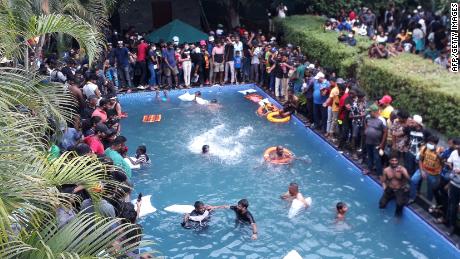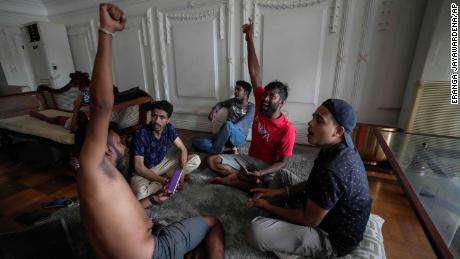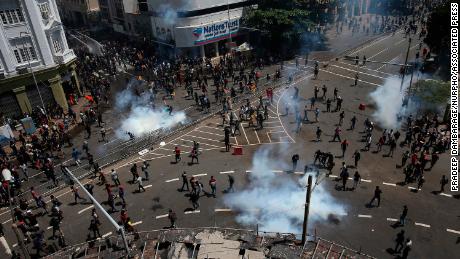What’s next for Sri Lanka as angry protesters occupy their leaders’ luxury houses?
Sri Lanka #SriLanka

However, the protesters say they won’t leave the luxury houses until both leaders have vacated their roles. President Gotabaya Rajapaksa is expected to step down on Wednesday, while Prime Minister Ranil Wickremesinghe tweeted his resignation Saturday but didn’t confirm his date of departure.
The resignations mark a major win for protesters, but the future of the country’s 22 million people is uncertain as they struggle to buy basic goods, fuel and medicine.
Here’s the latest.
Over the weekend tens of thousands of protesters massed outside the President’s office and residence before breaking through security cordons.
Striking images shared on social media show them singing protest songs and chanting slogans calling for Rajapaksa to resign. Images showed groups of protesters setting up barbecue pits to grill and cook food.
But the most dramatic footage showed protesters swimming in the President’s private pool. 

Protesters take over the compound of Sri Lanka’s Presidential Palace in Colombo.
Later on Saturday, protesters targeted Wickremesinghe’s house, setting fire to his private residence on Fifth Lane, an affluent neighborhood in the capital. Live video seen by CNN showed the building engulfed in flames as crowds gathered at the scene and cheered.
The leaders were not at their residences when the buildings were breached and were moved to secure locations before the attacks, according to security officials.


Protesters in Sri Lanka occupy the residence of the prime minister.
At least 55 people were injured in the protests, according to local medics on Saturday, who said that the figure included a lawmaker from eastern Sri Lanka and three people with gunshot wounds. Videos circulated on social media suggesting that soldiers shot at protesters outside the President’s residence, but the army denied opening fire.
Protests have been escalating in Sri Lanka since March, when public anger erupted on the streets over rising food costs, fuel shortages and electricity cuts as the country struggled to make debt repayments.


Police fire water and tear gas to disperse protesters gathering in a street leading to the President’s official residence on July 9.
What’s happening to the government?
Rajapaksa will officially step down on July 13, officials said, following an emergency meeting called by parliament speaker Mahinda Yapa Abeywardena.
Wickremesinghe posted on Twitter that he was stepping down “to ensure the continuation of the government including the safety of all citizens” but didn’t name a date.
Four other ministers also stepped down on the weekend — the latest in an exodus of senior officials. On April 3, the Sri Lankan government’s entire cabinet was effectively dissolved due to mass resignations by top ministers.
Some 26 cabinet ministers stepped down that weekend, including the central bank governor as well as the President’s nephew, who criticized an apparent social media blackout as something he would “never condone.”
Analysts and observers now say that parliament speaker Abeywardena will likely assume temporary charge of the country until the next president is elected by lawmakers to replace Rajapaksa and complete the rest of his term, due to end in 2024.
Following the protests over the weekend, the IMF said it was closely monitoring developments in the country.
“We hope to resolve the current situation that will allow for the resumption of our dialogue on an IMF-supported programme while we plan to continue technical discussions with our counterparts in the Ministry of Finance and Central Bank of Sri Lanka,” said IMF mission chiefs Peter Breuer and Masahiro Nozaki in a joint statement on Sunday.
What is life like now in Sri Lanka?
Despite earlier efforts by the government to ease the crisis, like the introduction of a four-day work week, Wickremesinghe declared the country “bankrupt” last Tuesday.
In several major cities including the capital, Colombo, desperate residents continue to queue for food and medicine, with reports of civilians clashing with police and the military as they wait in line.
In early July, Energy Minister Kanchana Wijesekera said the country had less than a day’s worth of fuel left.
The crisis has been years in the making, said experts, who point to a series of government decisions that compounded external shocks.
Over the past decade, the Sri Lankan government has borrowed vast sums of money from foreign lenders to fund public services, said Murtaza Jafferjee, chair of Colombo-based think tank Advocata Institute.
This borrowing spree has coincided with a series of hammer blows to the Sri Lankan economy, from both natural disasters — such as heavy monsoons — to man-made catastrophes, including a government ban on chemical fertilizers that decimated farmers’ harvests.
Facing a massive deficit, President Rajapaksa slashed taxes in a doomed attempt to stimulate the economy.
But the move backfired, instead hitting government revenue. That prompted rating agencies to downgrade Sri Lanka to near default levels, meaning the country lost access to overseas markets.
Sri Lanka then had to fall back on its foreign exchange reserves to pay off government debt, shrinking its reserves. This impacted imports of fuel and other essentials, which sent prices soaring.
Topping all that, the government in March floated the Sri Lankan rupee — meaning its price was determined based on the demand and supply of foreign exchange markets.
However, the plunging of the rupee against the US dollar only made things worse for ordinary Sri Lankans.